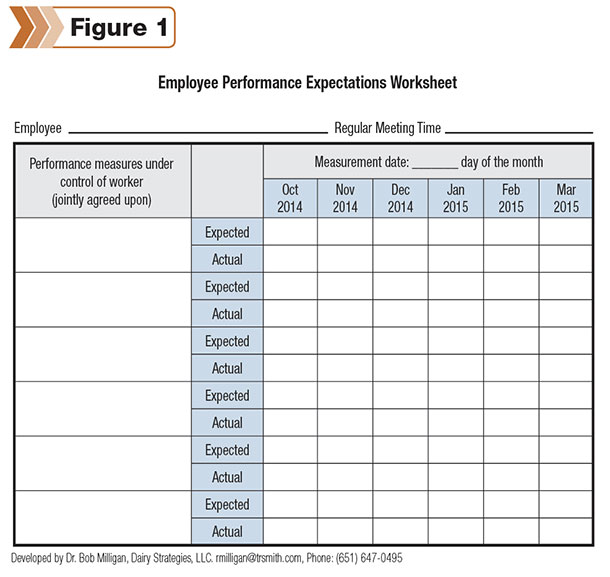What emotion do you think I observe the most when I visit with employees and their supervisors? The answer is: frustration. Many employees are very frustrated with their jobs and their supervisors. Many supervisors are frustrated – even exasperated – because their employees are frustrated and less productive than desired.
So, the $64,000 question is: Why is everyone so frustrated? The primary answer is: lack of clarity, or as I call it, “chalking the field.” The purpose of this article is to explain this answer.
To avoid this frustration, employees must be able to answer two questions:
1. What is expected of me?
2. How am I doing?
To better understand the importance of these two questions, let me share two examples.
First, place yourself in the following situations. You have been asked by your spouse to pick up several items at the grocery store. On the trip to the store, you discover you have left your cell phone at home. No worry, you have the list.
You are now in the store staring at the large variety of sizes, flavors, etc., for the first item on your list. You look at your list; it does not help. It is not sufficiently specific. You do not know which item to select. You have insufficient clarity.
Now, how would you feel in that situation? When I ask this question to audiences, the predominant answer is: frustration. My next statement is: Welcome to how most employees feel. In far too many cases, the supervisor believes he or she has clearly detailed expectations, but unfortunately, to the employee these expectations are like the list taken to the grocery store. This is a lack of clarity.
As I am writing this article, my Minnesota Twins just finished a series in Houston. In their last game, they scored three runs. My question to you is: Did they win or lose? The answer, of course, is “I don’t know” – because you did not tell me how many runs their opponent (Houston) scored.
Now think about when an employee knows his or her performance level but does not know what performance is expected. He or she is in the same predicament you are with my baseball game. He or she only knows half of what is needed to be able to answer the two questions: What is expected of me and how am I doing?
I will tell you how many runs Houston scored on the condition that you now clearly explain to your employees what is expected of them. Houston only scored one run.
Complete clarity or “chalking the field” actually includes more than just telling employees what is expected of them. The following list lays out, in probably too great detail, what I describe as complete clarity:
1. Every detail is clearly explained.
2. There is an explanation detailing why the expectation is important or needed.
3. There are opportunities to ask questions and, where appropriate, provide input (engagement).
4. The detailed description can be accessed by the employee (employee manual, job description, policy manual, etc.).
Let’s look at each of the four:
1. Every detail is clearly explained. This means clearly explained in terms and details that are clear to the employee. Remember that you have been doing many of these tasks most of your life. What seems obvious to you may be like the grocery store list to the employee.
2. Why. For an employee to take ownership in an expectation or a task, he or she must understand why the expectation or the task is reasonable and important. This comes from the explaining why.
3. Employee input. Explaining why (#2) and soliciting employee input capitalizes on the unique attributes of human beings – think, speak, feel – that facilitate employees being engaged with meeting the expectations and fulfilling the business mission.
4. The detailed description can be accessed by the employee. Think of some task that you do repetitively. Have you even gotten sloppy with the task? Have you even been uncertain of whether you are doing it exactly right? The answer, of course, is yes. We are human beings.
For employees, who typically have been doing tasks for far less time than you, these uncertainties are more common. In this situation even the most conscientious employee will be reluctant to come to you to check whether he or she is doing it absolutely correctly.
The solution is to have expectations, SOPs, policies, etc., recorded so an employee can overcome his or her concern without having to risk looking stupid.
How do you as a leader and a supervisor ensure that your employees can answer these two questions? We all know that successful crop and animal production requires excellent systems. Similarly, excellent employee performance and job satisfaction requires a system. We call this a performance management system.
I suggest you start with the following two components of a good performance management system:
1. A frequent, perhaps monthly, meeting with each employee where you do three things: review their performance over the last month by comparing actual performance to the expectations you and the employee jointly set last month, establish jointly with the employee performance expectations for the next month and discuss any issues, ideas, concerns, challenges, problems that either of you has. See Figure 1 for an example of the form I suggest.

2. Provide ongoing feedback and encouragement to the employee. PD
Bob Milligan is also professor emeritus, Dyson School of Applied Economics and Management, Cornell University.
For more information on the performance management system Bob Milligan implements with his clients, the Workforce Success system, contact him by email or call (651) 647-0495.

Bob Milligan
Senior Consultant
Dairy Strategies LLC






